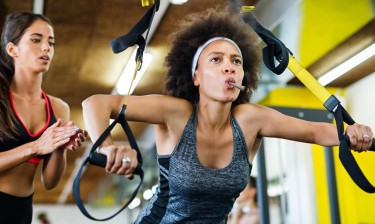
Cannabis, the Best Workout Bud-ie: Unveiling the Connection Between Marijuana and Exercise
In recent years, the perception of cannabis has been shifting from that of a stigmatized substance to a versatile aid in various aspects of life, including exercise.
A new study conducted by researchers at the University of Colorado Boulder sheds light on the fascinating relationship between marijuana and the exercise experience. The findings suggest that consuming cannabis before a run can enhance the overall exercise experience, making it more enjoyable and potentially reducing pain for regular cannabis users.
The study involved 49 runners who were asked to rate various aspects of their runs, both with and without the use of cannabis.
Published in the journal Cannabis and Cannabinoid Research, the study revealed that participants reported feeling “less negative affect, greater feelings of positive affect, tranquility, enjoyment, and dissociation, and more runner’s high symptoms” during their cannabis-fueled runs compared to non-cannabis runs.
One intriguing aspect of the findings was that participants ran slightly slower after consuming marijuana, with a difference of 31 seconds slower per mile, although the researchers noted that this difference was not statistically significant.
This implies that while cannabis may not necessarily enhance speed or performance, it could contribute to a more positive and pleasurable exercise experience, which is equally valuable for regular cannabis users.
Enjoying exercise is crucial to motivating people to stay active and maintain a healthy lifestyle. When exercise is enjoyable, it becomes a rewarding experience that individuals are more likely to pursue regularly. Unfortunately, the United States is facing a significant obesity epidemic, with nearly 42% of adults classified as obese. Surprisingly, despite the negative stereotypes of the “lazy stoner,” research suggests that cannabis use might unknowingly contribute to making the US fitter. Studies have shown that marijuana users have lower obesity rates than non-users, challenging long-standing misconceptions and highlighting the potential positive impact of cannabis on physical activity.
A reduction in pain post workout!
The reported reduction in pain levels after cannabis-fueled runs is an essential finding, especially for individuals seeking natural alternatives to manage pain during physical activities. The perceived exertion, or the effort perceived by the runners during their runs, did not significantly differ between cannabis and non-cannabis runs, suggesting that cannabis may not impact the perceived effort during exercise.
Experiencing muscle soreness after a workout is a common phenomenon known as Delayed Onset Muscle Soreness (DOMS). DOMS typically occurs 24 to 72 hours after intense physical activity or trying a new exercise routine. It is a result of microscopic damage to muscle fibers, accompanied by inflammation and the release of chemicals that sensitize pain receptors.
One way in which cannabis may help reduce post-workout pain is by its potential anti-inflammatory properties. Cannabinoids, such as CBD (cannabidiol), have been studied for their anti-inflammatory effects, which could aid in reducing the inflammation and swelling associated with DOMS. By mitigating the inflammatory response, cannabis might alleviate some of the pain and discomfort experienced after a strenuous workout.
Moreover, cannabis may also interact with the body’s endocannabinoid system to suppress pain signals. The endocannabinoid system is involved in regulating pain perception, and cannabinoids found in cannabis can bind to the body’s cannabinoid receptors to modulate pain signaling pathways. THC (tetrahydrocannabinol), the psychoactive compound in cannabis, has well-known pain-relieving properties and is used medically for chronic pain conditions.
Not to mention, cannabis promotes relaxation and reduces anxiety, which can indirectly contribute to pain relief.
When an individual feels more relaxed and less anxious, their perception of pain may be dampened. This could potentially enhance the overall post-workout recovery experience, as stress and anxiety can exacerbate feelings of soreness and discomfort. Additionally, cannabis may be move the body from the sympathetic to the parasympathetic mode. In other words, it activates the “rest and digest” mechanisms of the body which may be important when it comes to a speedy post workout recovery.
It is important to note that the study primarily focused on regular cannabis users, and further research is needed to explore the effects of acute cannabis use on exercise experiences among occasional or non-cannabis users. Diverse populations and settings should be studied to establish the long-term benefits and potential harms associated with this behavior.
A body of evidence emerging
The findings of this study align with previous research on the relationship between cannabis use and exercise. A 2019 study highlighted that individuals who used marijuana to enhance their workout routines tended to engage in a healthier amount of exercise. Moreover, older people who consume cannabis were found to be more likely to participate in physical activity, according to a study published in 2020.
These studies challenge long-standing stereotypes and misconceptions about cannabis users and their level of physical activity. The notion that marijuana consumption leads to lethargy and a lack of motivation has been debunked, with evidence suggesting the contrary. Frequent cannabis users were even found to be more physically active compared to non-users in a study published in 2021.
As researchers continue to explore the potential benefits of cannabis use, the medical applications of the plant have also been the subject of significant investigation. The use of medical marijuana has been associated with significant improvements in the quality of life for individuals suffering from conditions like chronic pain and insomnia, with these effects sustaining over time, according to a study published this year by the American Medical Association (AMA).
The positive effects of cannabis use on the exercise experience can be a game-changer for those seeking alternative methods to enhance their workouts and manage pain during physical activities.
However, it is essential to approach cannabis use for exercise with mindfulness and responsibility. As with any substance, individual reactions can vary, and understanding one’s own tolerance and limits is crucial to ensuring a safe and enjoyable exercise experience.
So, how can individuals harness the potential benefits of cannabis for their workouts responsibly?
1. Know Your Strains: Different cannabis strains can have varying effects on individuals. When using cannabis before exercise, opt for strains that are known for their energizing and uplifting properties rather than those that induce sedation.
2. Start Slow: If you are new to combining cannabis with exercise, start with a low dose and gradually increase it as you become more comfortable with the effects.
3. Listen to Your Body: Pay attention to how your body responds to cannabis use during exercise. If you feel any discomfort or adverse effects, adjust your consumption accordingly.
4. Stay Hydrated: Cannabis can cause dry mouth, so be sure to drink plenty of water before, during, and after your workout.
5. Choose Safe Environments: For outdoor activities, choose familiar and safe locations to ensure an enjoyable and stress-free experience.
6. Avoid High-Intensity Workouts: While cannabis can enhance the overall exercise experience, it may not be suitable for high-intensity workouts that require intense focus and coordination. Of course, if you take note of #3 on the list, you should be fine in this area as well.
7. Educate Others: Share your experiences responsibly with others, and encourage open and informed conversations about cannabis use in the context of exercise. Especially, let them know what works for you, what doesn’t, whether it’s best smoking before or after.
The sticky bottom line
cannabis has shown promising potential as the perfect “bud-ie” for working out, enhancing the exercise experience, and potentially encouraging more people to engage in physical activity. The studies and anecdotal evidence suggest that cannabis use before or during exercise can lead to a more enjoyable and less painful workout, making it a valuable tool for fitness enthusiasts seeking to optimize their training routines.
The implications of such a discovery go beyond just the individual benefits of pain relief and improved workout experience. If cannabis can indeed motivate more people to embrace an active lifestyle, the potential benefits for public health could be substantial. Obesity remains a pressing health concern in the United States, with approximately 42.4% of adults considered obese as of 2021. This epidemic is associated with a significant economic burden on taxpayers, costing the nation hundreds of billions of dollars annually in healthcare expenses, lost productivity, and related factors.
By harnessing the potential of cannabis to inspire more individuals to exercise regularly, we may see a decrease in obesity rates, resulting in fewer cases of obesity-related chronic conditions, such as heart disease, diabetes, and certain cancers. This reduction in obesity-related health issues could translate into substantial healthcare cost savings for the government and taxpayers.
Moreover, as we strive to improve public health and promote healthier living, the potential impact on human lives cannot be understated. Thousands of deaths each year are linked to obesity-related conditions, and empowering individuals to lead healthier lifestyles through cannabis-inspired exercise could significantly contribute to saving lives.
CANNABIS FOR OBESITY, READ ON..
CAN MARIJUANA HELP FIGHT OBESITY IN STUDY GROUPS?
- SEO Powered Content & PR Distribution. Get Amplified Today.
- PlatoData.Network Vertical Generative Ai. Empower Yourself. Access Here.
- PlatoAiStream. Web3 Intelligence. Knowledge Amplified. Access Here.
- PlatoESG. Automotive / EVs, Carbon, CleanTech, Energy, Environment, Solar, Waste Management. Access Here.
- BlockOffsets. Modernizing Environmental Offset Ownership. Access Here.
- Source: http://cannabis.net/blog/opinion/can-cannabis-help-reduce-obesity-because-everyone-at-my-gym-smells-like-weed
- :has
- :is
- :not
- 2019
- 2020
- 2021
- 24
- 31
- 49
- 72
- a
- About
- accompanied
- According
- active
- activities
- activity
- Additionally
- adults
- adverse
- affect
- After
- Aid
- align
- alleviate
- also
- alternative
- alternatives
- Although
- AMA
- American
- among
- amount
- an
- and
- Annually
- Anxiety
- any
- applications
- approach
- approximately
- ARE
- AREA
- AS
- asked
- aspect
- aspects
- associated
- Association
- At
- attention
- BE
- because
- become
- becomes
- been
- before
- behavior
- benefits
- BEST
- between
- Beyond
- billions
- bind
- body
- both
- Bottom
- burden
- by
- CAN
- cancers
- Cannabidiol
- Cannabinoid
- cannabis
- cannabis strains
- cannot
- cases
- Cause
- cbd
- certain
- challenge
- challenging
- chemicals
- Choose
- classified
- Colorado
- combining
- comes
- comfortable
- Common
- compared
- Compound
- conditions
- conducted
- considered
- consume
- consumption
- context
- continue
- contrary
- contribute
- conversations
- coordination
- Cost
- cost savings
- could
- course
- crucial
- damage
- deaths
- decrease
- Delayed
- Despite
- Diabetes
- DID
- differ
- difference
- different
- discovery
- Disease
- diverse
- Doesn’t
- dollars
- dose
- Drink
- dry
- during
- each
- Economic
- effects
- effort
- embrace
- empowering
- encourage
- encouraging
- engage
- enhance
- enhancing
- enjoyable
- ensure
- ensuring
- enthusiasts
- environments
- Epidemic
- equally
- especially
- essential
- establish
- Even
- everyone
- evidence
- Exercise
- expenses
- experience
- experienced
- Experiences
- explore
- facing
- factors
- familiar
- fascinating
- feel
- feelings
- fewer
- fibers
- fight
- finding
- findings
- fine
- fitness
- Focus
- focused
- For
- found
- frequent
- from
- further
- game-changer
- Go
- Government
- gradually
- greater
- Group’s
- gym
- harms
- harness
- Harnessing
- Have
- Health
- healthcare
- healthier
- healthy
- Heart
- Heart disease
- help
- High
- Highlighted
- highlighting
- HOURS
- How
- HTTPS
- human
- Hundreds
- if
- Impact
- implications
- important
- improve
- improved
- improvements
- in
- In other
- Including
- Increase
- indeed
- indirectly
- individual
- individuals
- inflammation
- inflammatory
- informed
- inspire
- interact
- into
- intriguing
- investigation
- involved
- issues
- IT
- ITS
- journal
- jpg
- just
- Know
- known
- Lack
- lead
- Leads
- less
- let
- Level
- levels
- Life
- lifestyle
- lifestyles
- light
- like
- likely
- limits
- linked
- List
- Lives
- living
- locations
- long-standing
- long-term
- long-term benefits
- lost
- Low
- lower
- maintain
- Making
- manage
- marijuana
- May..
- mechanisms
- medical
- Medical Applications
- Medical Marijuana
- mention
- methods
- might
- Mindfulness
- misconceptions
- mitigating
- Mode
- more
- Moreover
- Motivation
- mouth
- move
- my
- nation
- Natural
- nearly
- necessarily
- needed
- negative
- New
- note
- noted
- Notion
- Obesity
- occasional
- of
- older
- on
- ONE
- open
- Optimize
- or
- Other
- Others
- out
- Outdoor
- over
- overall
- own
- Pain
- painful
- participants
- participate
- Pay
- People
- per
- perceived
- perception
- perfect
- performance
- phenomenon
- physical
- Physical activity
- Physically
- plato
- Plato Data Intelligence
- PlatoData
- Plenty
- populations
- positive
- Post
- potential
- potentially
- pressing
- previous
- primarily
- productivity
- promising
- promote
- promotes
- properties
- public
- public health
- published
- quality
- Rate
- Rates
- rather
- reactions
- Read
- recent
- recovery
- reduce
- reduces
- reducing
- reduction
- regular
- regularly
- regulating
- related
- relationship
- relaxation
- release
- relief
- remains
- Reported
- require
- research
- Research suggests
- researchers
- response
- responsibility
- responsibly
- result
- resulting
- Revealed
- rewarding
- routines
- Run
- runner
- runs
- s
- safe
- saving
- Savings
- seconds
- see
- seeking
- settings
- Share
- SHIFTING
- should
- shown
- signals
- significant
- significantly
- Smoking
- So
- some
- speed
- speedy
- start
- States
- statistically
- stay
- sticky
- Strains
- stress
- strive
- studied
- studies
- Study
- subject
- substance
- substantial
- such
- suffering
- suggest
- Suggests
- suitable
- sure
- Symptoms
- system
- Take
- taxpayers
- tetrahydrocannabinol
- than
- that
- THC
- The
- their
- Them
- These
- this
- this year
- those
- thousands
- Through
- time
- to
- tolerance
- tool
- Training
- translate
- typically
- understanding
- unfortunately
- United
- United States
- university
- unveiling
- us
- use
- used
- users
- using
- Valuable
- various
- versatile
- was
- Water
- Way..
- we
- weed
- WELL
- well-known
- were
- What
- when
- whether
- which
- while
- WHO
- with
- without
- words
- working
- working out
- workout
- workouts
- works
- year
- years
- you
- Your
- zephyrnet












